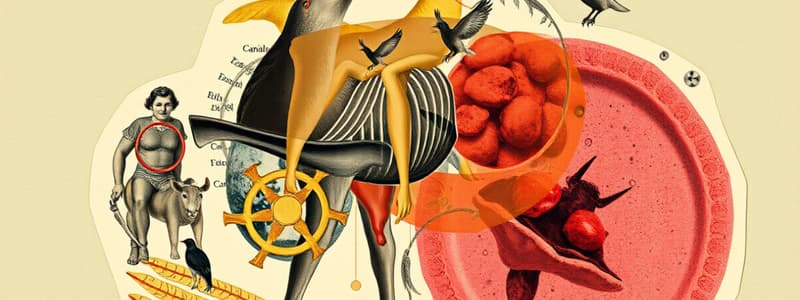Podcast
Questions and Answers
Which course focuses primarily on the structure and function of cells and genetic concepts?
Which course focuses primarily on the structure and function of cells and genetic concepts?
- ZOO 114 - Principles of Cell Biology and Genetics (correct)
- ZOO 115 - Introductory Ecology
- ZOO 112 - The Mammalian Body
- ZOO 116 - Introductory Invertebrate Zoology
What is the total number of lecture hours for the course ZOO 112 - The Mammalian Body?
What is the total number of lecture hours for the course ZOO 112 - The Mammalian Body?
- 45 hours (correct)
- 60 hours
- 30 hours
- 15 hours
Which lecturer is associated with the topic of genetic inheritance and variation in ZOO 114?
Which lecturer is associated with the topic of genetic inheritance and variation in ZOO 114?
- Dr. Chiaka I. Anumudu
- Dr. G.C. Alimba
- Charles Latunji (correct)
- Prof. A.A. Bakare
How many total units does the course ZOO 118 - Practical Zoology have?
How many total units does the course ZOO 118 - Practical Zoology have?
What is covered in the last two weeks of the ZOO 114 course?
What is covered in the last two weeks of the ZOO 114 course?
What is the primary assertion of the cell theory?
What is the primary assertion of the cell theory?
Which characteristic is true of prokaryotic cells?
Which characteristic is true of prokaryotic cells?
Which statement best describes eukaryotic cells?
Which statement best describes eukaryotic cells?
In the correct sequence of biological organization, what comes directly after cells?
In the correct sequence of biological organization, what comes directly after cells?
What distinguishes prokaryotic cells from eukaryotic cells?
What distinguishes prokaryotic cells from eukaryotic cells?
Flashcards are hidden until you start studying
Study Notes
Department of Zoology Overview
- 100 level courses include ZOO 112, ZOO 114, ZOO 115, ZOO 116, ZOO 117, and ZOO 118.
- ZOO 112 covers mammals; ZOO 114 focuses on cell biology/genetics; ZOO 115 introduces ecology; ZOO 116 and ZOO 117 focus on invertebrate and vertebrate zoology respectively; ZOO 118 involves practical zoology.
- Course structures include lectures (LH) and practical hours (PH) with corresponding unit values.
Principles of Cell Biology and Genetics Course Outline
- Course duration is divided into topics covered over several weeks with various lecturers.
- Key topics include cell structure, biological organization, genetic inheritance, energy production, bioethics, and embryogenesis.
Cell Theory
- Formulated in 1839; states that:
- All living organisms consist of one or more cells.
- The cell is the smallest unit of life.
- All cells arise from pre-existing cells.
- Recognizes two cell types: prokaryotic and eukaryotic.
Prokaryotic Cells
- Structurally simple but diverse; includes bacteria and blue-green algae.
- Lack membrane-bound organelles and defined nucleus.
- Genetic material is a single, naked DNA molecule found in the cytoplasm.
Eukaryotic Cells
- More complex with membrane-bound organelles and defined nucleus.
- Genetic material organized into chromosomes with proteins.
- Stages of protein synthesis are separated between nucleus and cytoplasm.
Levels of Biological Organization
- Organization progresses from cells, tissues, organs, organ systems, to organisms.
- Tissues consist of similar cells, while organs are made of different tissues.
Types of Tissue
- Four main types in humans: epithelial, connective, muscular, and nervous.
Epithelial Tissue
- Covers body surface and lines internal cavities.
- Functions include protection, secretion, and sensation.
- Classified by cell shape (squamous, cuboidal, columnar) and layer (simple, stratified).
Connective Tissue
- Most abundant tissue type, providing support and protection.
- Includes loose connective tissue, adipose tissue, cartilage, bone, blood, and lymph.
Muscular Tissue
- Three types in vertebrates: skeletal (voluntary), smooth (involuntary, found in organs), and cardiac (involuntary, heart-specific).
Nervous Tissue
- Composed of neurons and glial cells.
- Receives stimuli and conducts impulses throughout the body.
Nucleus
- Control center containing DNA, organized into chromatin and chromosomes during cell division.
- Surrounded by a nuclear envelope with nuclear pores facilitating molecular exchange.
Endoplasmic Reticulum (ER)
- Network of membranes; consists of rough ER (with ribosomes) and smooth ER (without ribosomes).
- Rough ER synthesizes proteins, while smooth ER synthesizes lipids and carbohydrates.
Ribosomes
- Molecular structures made of RNA and proteins; crucial for protein synthesis.
- Ribosomes exist as polyribosomes or attached ribosomes to the ER.
Golgi Complex
- Involved in packaging and transporting molecules; collects and modifies ER products.
Lysosomes
- Membrane-bound bodies containing digestive enzymes for breaking down cell components; termed "suicide bags."
- Exist in different phases: primary, secondary lysosomes, residual bodies, and autophagic vacuoles.
Peroxisomes
- Enzyme-filled organelles, primarily breaking down hydrogen peroxide and other toxic substances.
- Found in specific cells like liver and kidney in animals.
Centrosome
- Composed of two centrioles, acts as the microtubule organizing center during cell division.
Cilia and Flagella
- Motile structures on eukaryotic cells; flagella are few and long, while cilia are numerous and short.
Chloroplasts
- Organelles unique to plants and algae; perform photosynthesis using chlorophyll.
- Contain their own DNA and can reproduce independently, generating food and oxygen.
Studying That Suits You
Use AI to generate personalized quizzes and flashcards to suit your learning preferences.




